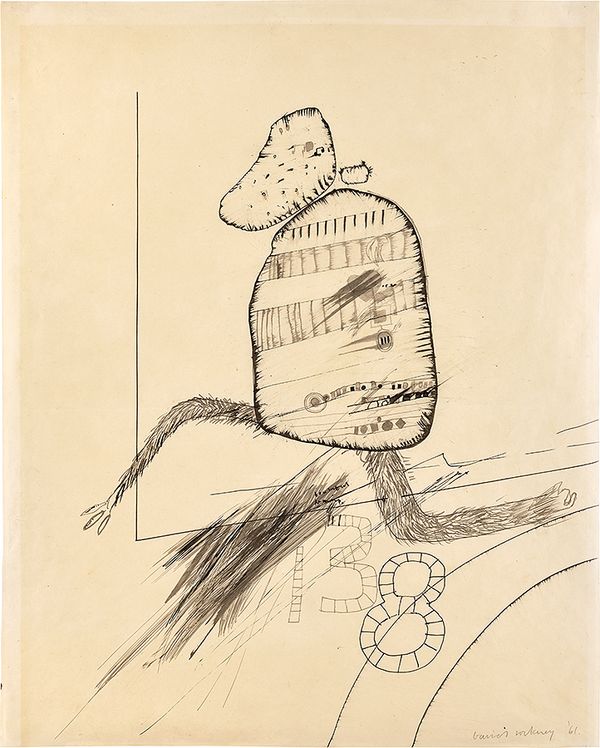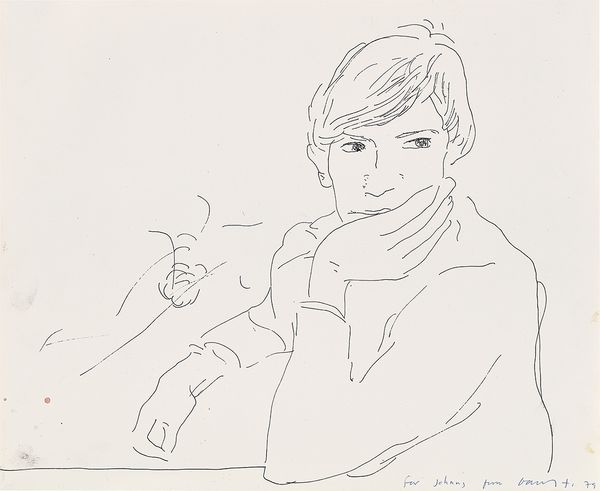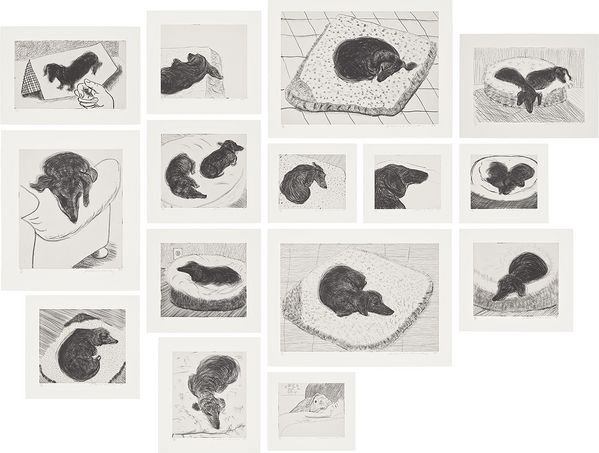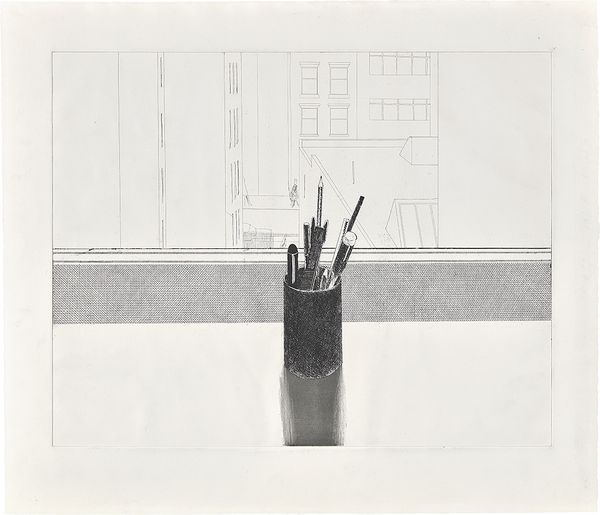David Hockney, Still Life, 1969. Evening & Day Editions London.
Drawing is at the core of David Hockney’s artistic world, from his earliest works on paper to his latest iPad innovations. One of the master draftsmen of our era, Hockney has always wielded his pencil with confidence, even as a child drawing on anything he could, be it the walls of his childhood home or the margins of his brother’s comic books. For Hockney, drawing isn’t just a technique but a deeply personal way of interpreting the world and understanding the people closest to him. It is through the simple yet profound act of mark-making that he continues to explore and redefine his unique perspective on life. While echoing the emotional depth of Rembrandt, the precision of Ingres, and the Cubist approach of Picasso, Hockney’s use of line is unmistakably his own. For him, drawing is a constant of the everyday, as art historian Sarah Howgate observed: “When he is not smoking, he is drawing; he smokes to think about drawing in the pauses between mark-making.” Here, we delve into Hockney’s exquisite use of line both on paper and the etching plate, examining how it reflects his artistic evolution and the central role it plays for him, not just in his art but also in his life.
He was never without a pencil or a pen. Drawing was his way of seeing the world, and he did it with such ease.
—Margaret Hockney, David’s sister
When Hockney began his studies at the Royal College of Art in 1959, drawing was still a compulsory discipline. At a time when Abstract Expressionism was the dominant trend, Hockney, ever the contrarian, chose to focus on the rigorous discipline of life drawing. While many of his peers were drawn to abstraction, Hockney immersed himself in the challenge of creating detailed, academic studies of a human skeleton he found in the cast room, each meticulously drawn over several weeks. A testament to his innate ability as a draughtsman, his friend and fellow artist R.B. Kitaj was struck by the precision and emotion that Hockney could evoke with his line work, recalling: “I spotted this boy with short black hair and huge glasses, wearing a boiler suit, making the most beautiful drawing I’d ever seen in an art school.”
Although Hockney’s tutors encouraged him to experiment with abstraction, after initial forays he quickly realized it wasn't for him. “I deliberately chose to abandon abstract expressionism and return to the figure because it wasn’t me — I’m a figurative painter," he later reflected. Following this definitive decision — one the artist would never return from — Hockney embraced figuration and draughtsmanship, setting him apart from most of his fellow students.

David Hockney, Hairy Legs, 1961. Evening & Day Editions London.
This is demonstrated in his ink drawing entitled Hairy Legs, of 1961, which presents a peculiar, imaginary creature, both amusing and enigmatic. With its potato-like body and spindly legs, the figure has a childlike quality, resembling a stuffed toy or rudimentary robot. Hockney’s varied use of line — from rough, hair-like spikes to delicate, scribbled textures — infuses the drawing with energy and character. This variety of lines enhances the creature’s slightly human, slightly animal, and entirely otherworldly appearance. While its rounded form and cartoonish features evoke innocence, there’s an underlying complexity, as if the figure is trying to communicate something deeper — perhaps a reflection of Hockney’s emerging self, capturing the youthful, exploratory spirit of his student days at the Royal College.

David Hockney, A Rake's Progress, 1961–63. Evening & Day Editions London.
Hairy Legs was drawn at a seminal time in Hockney’s life and development as an artist. In the summer of 1961, Hockney traveled to the United States for the first time. Two key events during this trip marked a turning point in Hockney’s career: he dyed his hair blonde, and he began work on A Rake’s Progress, his first major series of etchings. Both Hairy Legs and A Rake's Progress exhibit meticulous attention to detail, with text, varying graffiti-like lines, and quick, precise mark-making that capture the complexities of character and setting. The fluid, expressive quality of the draughtsmanship in the drawing mirrors the dramatic, narrative-driven line work found throughout the etchings, revealing a consistent mastery in conveying both movement and emotion. These works demonstrate how, for the young Hockney, drawing was not just a means to an end but a foundational practice that allowed him to explore and express his innermost thoughts and feelings. It was through drawing — on paper and in etching — that he developed his unique style, characterized by a highly attuned handling of line and a deeply compelling ability to express his own identity through draughtsmanship.
Having fantasized about New York since childhood, its reality during Hockney’s 1961 visit did not disappoint. Struck by the “sheer energy of the place,” Hockney extended his stay and, after a meeting with William S. Lieberman, the then-curator of prints and drawings at the Museum of Modern Art, embarked on A Rake’s Progress. This sixteen-part series of etchings is a modern reinterpretation of William Hogarth’s 1735 engravings. While Hogarth’s series tells a tale of dismal despondency, Hockney reworked it into a semi-autobiographical narrative following the young artist’s first visit to New York. Similarly to the narrative, Hockney's draughtsmanship departs starkly from Hogarth’s chaotic realism, employing sharp, rough lines, abstracted figures and bold plumes of arresting red ink. Despite its spontaneous appearance, Hockney devoted considerable time to refining this series, distilling the compositions over eighteen months to achieve notable cohesion in color, clarity, and form. The outlined figures offset the blackened aquatint contrasts, while empty space balances areas of intense imagery, guiding the viewer through the narrative sequence. Hockney’s protagonist, a doppelganger sporting bleached hair and oversized circular glasses, serves as a comical reference to the artist’s own appearance.

David Hockney, from Two Self Portraits, 1982. Evening & Day Editions London.
Self-portraits have been central in Hockney’s work and he has frequently drawn them since his early days at the Bradford School of Art to his recent iPad drawings. Each self-portrait is a moment of introspection, a chance for Hockney to engage with himself as both subject and artist. In his early 1980s self-portrait drawn within the pages of the The Faces of My Friends book, Hockney captures his appearance and, more importantly, the essence of his character with a handful of masterfully placed lines. The lightness and simplicity of the drawing conveys the playful yet purposeful movement of the artist’s hand as he sketched the oversized glasses framing his quizzical gaze. Staring back into Hockney’s eyes, the viewer experiences a palpable sense of introspection, as if looking into a mirror. The loose, confident strokes capture a fleeting moment of self-reflection, frozen in time by the lightest and most skillful of touches. While Hockney has always loved to draw those closest to him, in drawing himself, he confronts the challenge of truly seeing and understanding his own face — not just the technicalities of its contours but how it moves, speaks, and expresses emotion. This delicate balance of self-exploration and artistic precision makes each self-portrait an intimate and highly personal interaction.

David Hockney, Untitled (Portrait of Johnny), 1979. Evening & Day Editions London.
This same delicacy of line and emotional depth is evident in Hockney’s portrait of John “Johnny” Reinhold, a prominent figure in the New York art scene and a close friend of the artist. Reinhold, known for his work as a diamantaire and his deep connections within the art world, is portrayed with an elegant simplicity that belies the complexity of capturing such a close likeness. Hockney uses a series of fluid, confident lines to convey Reinhold’s relaxed yet thoughtful demeanor, with his head resting lightly on his hand. The gentle curve of his hair and the subtle angles of his face are rendered with minimal yet precise strokes, capturing the sitter’s curious and perhaps impatient expression. Hockney's confidence in line and his keen eye for detail allow him to encapsulate movement and expression in a way that feels both spontaneous and highly controlled. In this drawing, Hockney’s ability to distill Reinhold's character into a few strategic lines is a testament to his deep understanding of both his subject and his medium.
Portraits aren’t just made up of drawing, they are made up of other insights as well.
—David Hockney

David Hockney, Dog Wall, 1998. Evening & Day Editions London.
Hockney has always drawn those closest to him, and in the late 1990s, he turned his attention to his pet dogs, Stanley and Little Boodgie. In the 1980s and early 1990s, Hockney lost many friends to AIDS and was also very affected when Henry Geldzahler succumbed to liver cancer in 1994. His two tiny dachshunds proved essential in helping Hockney through this difficult time in his life. Hockney’s repeated meditations on his two dachshunds epitomize his devotion to the dogs, with Dog Wall serving as the most refined, multi-faceted representation of their individual personalities.
The Dog Wall portfolio was produced soon after Hockney’s close friend and master printer Maurice Payne moved into the artist’s Los Angeles home for a year. In Hockney’s Montcalm Avenue residence, Payne set up a fully functioning etching studio. He began leaving prepared etching plates all around Hockney’s house, which the artist would then spontaneously use as he might a sketchbook. This sense of freedom is exhibited in every individual charming etching that comprises Dog Wall, with each print serving as an endearing study of the dachshunds. Captured at speed before the dogs darted off again, Hockney uses variations in line to depict the pair as rapidly yet realistically as possible. In some prints, delicately and sporadically placed lines conjure up the face of an animal at rest, with the negative space of the unmarked surface acting as an oasis of stillness. In other etchings, densely packed lines overlap into pulsating balls of energy, adding vitality to the prints and conveying the lively personalities of Stanley and Little Boodgie, even in the brief moments of calm that Hockney sought to capture. A composite portrait of his two beloved pets, Dog Wall is an exquisite study in draughtsmanship and a testament to Hockney’s skilfull ability to draw those closest to him with such captivating and tender affection.
Whether drawing an imagined narrative, a friend, a self-portrait, or his beloved dogs, the simple but profound act of drawing is central to who Hockney is. His drawings, both on paper and the etching plate, are abundant with feeling and capture the nuances of his subjects with a simplicity that belies the complexity of his process. Over a lifetime of drawing, Hockney has used line to refine his artistic technique and explore the depths of his own identity and relationships. From his early days at the Royal College to his latest works made on an iPad, Hockney’s mastery of line continues to inspire and captivate. Ever inquisitive, this deep-rooted curiosity to see and draw the world around him is enduring, as the artist stated: “I’m still excited about what I will do tomorrow. It’s not an end. It’s another beginning.”
What an artist is trying to do for people is bring them closer to something, because of course art is about sharing; you wouldn’t be an artist unless you wanted to share an experience, a thought. I am constantly preoccupied with how to remove distance so that we can all come closer together, so that we can begin to sense we are the same, we are one.
—David Hockney
Recommended Reading
Specialist Picks: How Much is That Rhinoceros in the Window? >
